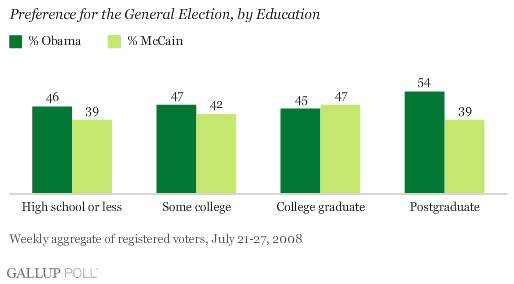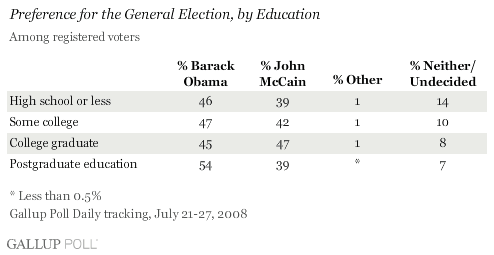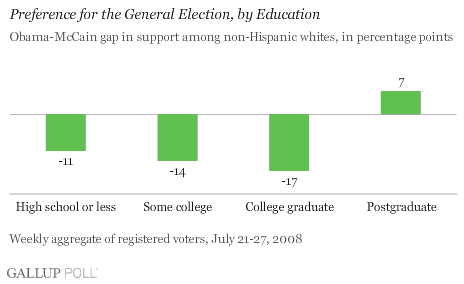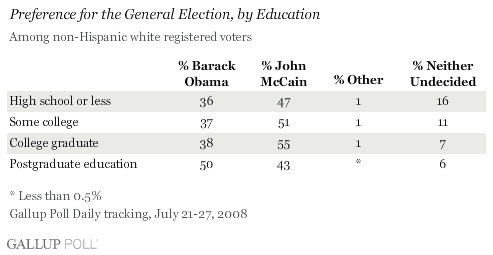PRINCETON, NJ -- Barack Obama has by far his greatest strength among voters with postgraduate education, while John McCain has his highest level of support among voters who have a college degree but no postgraduate education.

This analysis is based on Gallup's detailed weekly assessment of the vote within subgroups.
The latest weekly update, consisting of more than 6,000 interviews conducted July 21-27, shows that the relationship between education and the Obama versus McCain margin in the presidential vote is a U-shaped curve of sorts. Presumptive Democratic nominee Obama does well compared to McCain among those without a college degree, and among those with postgraduate education. McCain's support increases on a relative basis among those with a college degree.

There is also an interesting trend in the percentage of each educational group that is undecided. The percentage of undecided voters is highest among those with the least formal education, and shrinks among groups with higher average educational attainment. The data indicate that McCain's strength among college graduates, compared to his position among those with less than a college education, is based on his gain as the percentage of undecideds decreases. Obama's percentage of the vote is relatively constant across all three groups of those with college educations or less.

Whites
Obama wins overwhelmingly among blacks across all educational levels. An analysis of the vote by education among whites (with blacks and Hispanics taken out of the equation), however, shows the same basic pattern as is the case among all voters.
Overall, as has been well-established, McCain does much better against Obama among whites in general than he does among nonwhites. The presumptive Republican nominee in fact "wins" in each educational group of whites except those with postgraduate education. But, as is the case for all voters, McCain's relative advantage is greatest among college graduates, and the data to a degree reflect the same U-shaped curve evident among all voters.


The accompanying chart displays the trend in the Obama-McCain gap over the summer months on a weekly basis.
There has been some weekly variation, as can be seen. In every week, however, Obama has had his greatest margin over McCain among those with postgraduate education.
McCain's margin over Obama among the college graduate group has been a little more consistent over the last three weeks. At several points in June, Obama beat McCain among this group.
Still, there does not appear to be a meaningful pattern in this trend so far this summer. The relative appeal of Obama and McCain, whose standing in the ���۴�ýPoll Daily tracking has remained roughly the same all summer on an averaged basis, does not appear to have shifted much within specific educational categories.

Implications
The overall pattern of the vote by education this summer is roughly consistent with that of the last election in 2004, although the margins within each group vary across elections. In 2004, Gallup's final analysis of the vote showed John Kerry winning among voters with high school educations or less, and winning among those with postgraduate education -- similar to Obama's edge in these groups today. Bush won among those with college degrees (but no postgraduate education) in 2004, as does McCain today (but by a slimmer margin). The biggest difference between the two years: Bush won strongly among those with some college in 2004, whereas Obama leads among that group at this point this year.
Survey Methods
Results for the week of July 21-27 are based on telephone interviews with 6,248 registered voters, aged 18 and older, conducted July 21-27, 2008. For results based on the total sample of registered voters, one can say with 95% confidence that the maximum margin of sampling error is ±2 percentage points.
Results for non-Hispanic whites for the week of July 21-27 are based on telephone interviews with 5,202 registered voters who are non-Hispanic whites, aged 18 and older, conducted July 21-17, 2008. For results based on the total sample of these registered voters, one can say with 95% confidence that the maximum margin of sampling error is ±2 percentage points.
Interviews are conducted with respondents on land-line telephones (for respondents with a land-line telephone) and cellular phones (for respondents who are cell-phone only).
In addition to sampling error, question wording and practical difficulties in conducting surveys can introduce error or bias into the findings of public opinion polls.
To provide feedback or suggestions about how to improve Gallup.com, please e-mail feedback@gallup.com.
